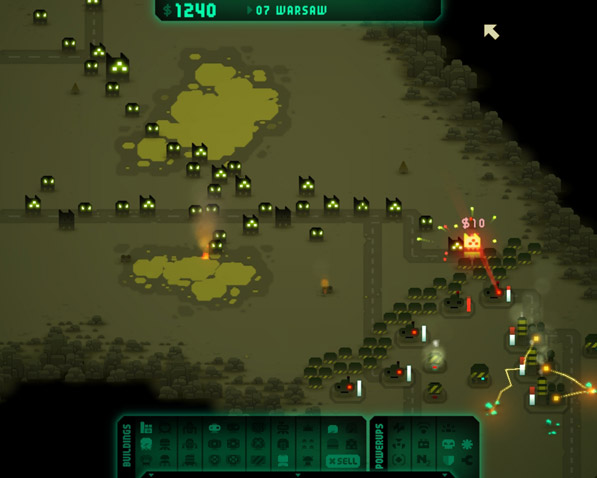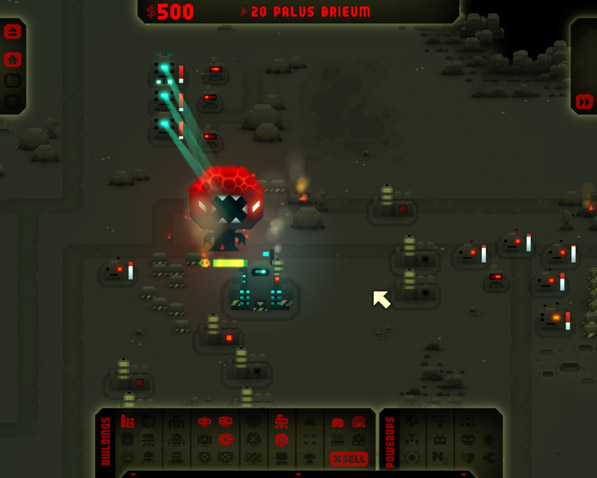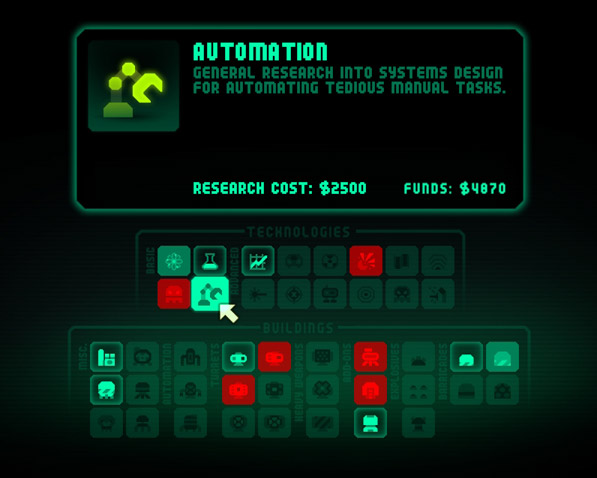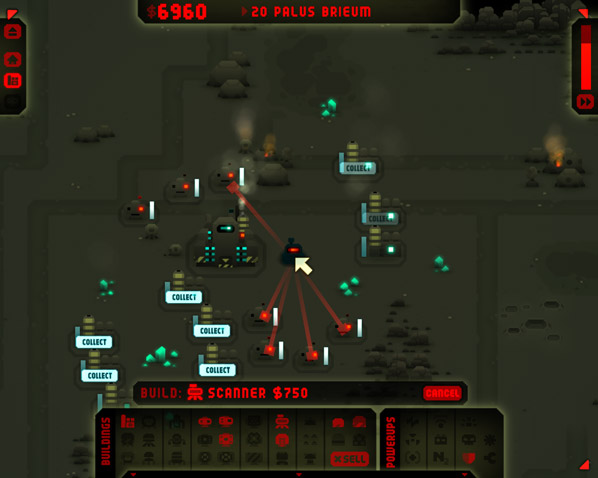I’ve always been a turtler. All that progress, pushing forward, actually doing stuff — it’s not for me. I’d rather just sit in my hardy shell, pipe and newspaper in hand, and hatch a plan; a plan to build more walls, a plan to build more towers, a plan to make my shell hardier. Yes, I’m a real-time strategy coward.
I realised this during the early C&C multiplayer days when I spent more time liberally peppering my base with advanced guard towers or tesla coils than brainlessly amassing a mammoth tank armada to flatten my foe — usually my brother Lewis. The problem was that he came to know my biggest weakness: I can’t handle more than a single task at a time. If he attacked me from more than one angle, before my defences were up, then my cognition would cough and splutter and I’d become a panicked mess haplessly clicking and trying to appear as if I know what I’m doing.
Perhaps the worst example of this cognitive clogging was a few years ago just after I’d finished Age of Mythology. I asked Lew (who’d not played it before) if he fancied a quick LAN match, after all, we were still living with our parents and our computers were always connected. A cheap win I thought: I know the tech trees and the units and the game’s subtleties; how could he possibly contend with that? At the very least it would even the odds. He chose the Egyptians, the fastest, cheapest culture — much like the Brotherhood of Nod and the Allies — while I chose the Greeks, a powerful but relatively slow and expensive culture — much like GDI and the Soviets. Within minutes his economy was booming and he was well on his way to progressing an age. I, on the other hand, had built a mighty fine looking wall. In no less than twenty minutes a pack of Anubites (jackal-dog-things) were slaughtering my resource gatherers effectively severing the umbilical cord to my foetus of a civilisation. The resource gatherers were called inside the relative safety of my settlement walls and told to go indoors, this would hopefully buy me enough time to dispatch the aggressors. Unbeknown to me however, was that Lew had sussed out that his canine killing machines could vault straight over my now not-so-mighty walls. Needless to say it was a blood bath shortly afterwards.
The bottom line to this anecdote is that I’m crap at spinning the plates of real-time strategy and in due course I would discover my calling: tower defence; a genre which typically requires you to pepper your base with guard towers and sit there doing very little else.
Which brings us to Puppy Games’ Revenge of the Titans, a tower defence game that features elements of real-time strategy. The Titans are invading and you play as humanity’s last stand against them. The campaign mode begins on Earth in Basingstoke (no less) which acts as a tutorial of sorts but soon ventures out across the solar system towards the Titans’ origin, uh, Titan, where you’ll presumably snuff them out for good. It’s a simple shlocky B-movie premise rendered in Puppy Games’ inimitable (and gorgeous) visual style and set to a coolly spaced out metal-synth soundtrack by Dave Sunerton-Burl.
Let’s get the formalities out of the way. Each level essentially plays out the same: assess the map and the entry points of the Titans (and the roads that guide them in), extract funds from mineral deposits and buy turrets to dispatch the Titans before they destroy your base. Resources are amassed by shooting Titans and placing refineries next to mineral deposits scattered about each stage (usually close to your base). Once a refinery is full, its cash needs to be collected manually by clicking on it so that it can resume extraction. Extraction ends when the mineral deposit has been depleted. More refineries allow you to extract more cash quicker but also require more effort to collect. Your remaining cash rolls over to the next level and can be used to research new technology so being frugal is vital to your success.
Random pick-ups also appear across each level for short periods of time, these are often small cash bonuses but can sometimes be special weapons, temporary buffs and permanent upgrades. Special pick-ups are stored for use and, best of all, stack if you collect more than one. In the same way as your cash they roll over to the next level so there’s a nice use-it-or-stockpile-it mechanic going on here.
On the final stage of each planet or moon there is a boss to defeat in addition to the usual hordes of Titans, these are large lumbering creatures capable of destroying your base on contact and take a lot of fire power to bring down. Each level automatically starts on the hardest difficulty but can be restarted so that an easier version is generated. If you don’t want to restart the level and lower the difficulty then it’s possible to play from an earlier mission in the hopes of acquiring more resources and/or tech, so there’s plenty of head room for anyone having trouble.
Completing a level on a higher difficulty will give you a bigger medal — not that size matters. Medals are awarded for anything from hoarding a load of cash to playing recklessly, and act as little more than a fun sweetener; I suppose you could brag about them if you’re one of those types of people. There are three game modes to choose from: campaign, endless and survival. The latter two, combined with the possibilities of the extensive tech tree, give the game tremendous replay value.
What makes Revenge of the Titans stand out from most tower defence games, aside from its visuals, is the way in which it chaotically uproots many of the conventions we’ve come to expect from the genre, transforming what are typically composed skirmishes into frenetic, panicked last stands. There comes a point in nearly every tower defence conflict where, after fighting to get the upper hand for the best part of a level, the player gets a footing against the enemy and the difficulty sort of drops off. It’s that moment where you can finally sit back and watch your crack combination of carefully arranged towers effortlessly dispatch the encroaching hordes. It’s one of the genre’s simple pleasures. In Revenge of the Titans this simple pleasure is practically non-existent. Even the tough stages on Immortal Defence and Defence Grid had moments where you could kick back and admire your handiwork but here … here it’s frantic from plucky start to strangled finish. That’s not to say that Revenge of the Titans is too difficult, it just has a very different kind of difficulty, one that revolves around juggling many simple tasks. You see, there’s nearly always something to do, whether it be keeping your turrets loaded with ammunition or collecting cash from your refineries. This all has to be done manually (unless you decide to pour resources into automation tech which we’ll come to later) so the simple task of defending becomes a juggling act of collecting resources for more turrets, more tech and other toys, and holding that front line against the Titans by keeping your turrets topped up with ammo. This wouldn’t be too bad if the Titans were as brainless as the doomed automatons in nearly all other tower defence games, but they’re not: they flank your defences, stretch your attention and run amok just when you think you’ve got them nailed. They want to survive.
At first this made me furious: how was I supposed to know where to place my turrets if the Titans were going to vary their attack pattern? How could I afford to plug every gap in my defences? It all felt a bit unfair, but then I realised that this wasn’t a problem with Revenge of the Titans, it was a problem with my expectations of the genre. Enemies that preserve themselves?! How in God’s name could Puppy Games do such a thing?! These sneaky little bastards weren’t stupid enough to simply march to their deaths so I was going to have to play it very differently to how I’d usually play a tower defence game. I began placing my cheapest turrets to try and shepherd the Titans towards areas which I would then heavily fortify outwards from; I started delaying the placement of my defences so that they didn’t have a chance to flank them; refineries were placed as far away from roads as possible and barricaded in, on the off chance that the Titans would fancy a mineral nibble. These tactics came about simply because the enemy was adaptive, a quality that I’ve never witnessed before in tower defence and a quality that forced me to be proactive.
That tech tree that I mentioned earlier: between each stage you have the ability to invest your cash into researching different technologies. Some technologies unlock other avenues of research which in turn unlock more tech. New turrets, turret add-ons, refinery efficiency improvements, barricades, land mines and explosives, droids, pointer-controlled weaponry and as mentioned earlier, automation and much more. As of yet I’ve not managed to explore as much of the tech tree as I’d like simply because it’s a costly business, but it’s perhaps the single most compelling and rewarding element in the game. You’ll want to unlock shiny new tech that suits your play style and due to the scarcity of resources you’ll try to become as efficient and thrifty as possible on each level in order to attain it. It’s addictive and creates lots of short term goals that pull you from one level and push you into the next.
On my first play session (before the beta got updated and made tech much harder to obtain) I invested in automation tech, a line of technology that allows you to position robots to carry out tasks like reloading your turrets and collecting cash automatically, alleviating much of the micromanagement mentioned thus far. On my current play session I’ve invested in super useful turret add-ons and deadly explosives. Revenge of the Titans doesn’t allow you to directly upgrade your turrets like traditional tower defence games and instead opts for a turret add-on system which allows you to augment multiple turrets at a time: scanners increase their range, cooling towers increase their rate of fire while ammo batteries increase their ammo capacities. Until five minutes ago I wasn’t aware that these effects could be stacked up to four times. OMG indeed. It’s surprising how well this system works and it encourages you to position your turrets in a way that makes them easier to augment collectively, saving cash and maximising their effectiveness.
Land mines and barricades are a match made in heaven and go a long way in thinning out the Titans before they even get close to your turrets. Only a certain number of each can be used per level so they have to be used considerately. Like all structures in the game (including land mines), barricades are placed by clicking and dragging, creating lots of little barricade segments — sort of like drawing a wall. This is a great way of quickly deploying numerous larger structures like turrets and refineries but for barricades it felt quite unwieldy at first, especially for longer stretches. As the Titans pocked more and more holes in my lines of barricades it became clear that this swift method of deployment was perhaps preferable to a C&C style post-to-post system simply because of how much gap plugging you have to do when things start getting hectic and how uneven the terrain can be. And that’s the thing, there are mechanics in Revenge of the Titans that are initially hard to get along with, whether it be the constant micromanaging of your turrets and refineries or the upkeep of your barricades and minefields; it’s impeccably geared to be a clusterfuck of a game. This is Revenge of the Titans not Revenge of the Pansy-Assed Chimps.
So far Puppy Games have hit a real sweet spot between tower defence and real-time strategy, in much the same way as Pelfast’s often overlooked Comet Crash did on PSN. Some people may be turned off by the twitchy gameplay and frenetic plate spinning — I was certainly worried that I wouldn’t be able to handle it — but somehow Revenge of the Titans has won me over. If it had been a fully fledged attack and defend real-time strategy title with the same degree of micromanagement then it would’ve garnered a hasty Fuck Off from me, but, in the absence of any goals outside of ‘defend your base,’ it adds an extra dimension to the experience and a heady slew of dilemmas: do you reload your turrets or augment them? Or do you buy more? Do you risk reloading your turrets in unison leaving your front lines open or do you stagger them so that there’s always something capable of firing? Do you buy fewer heavy turrets or lots of cheaper, weaker turrets? Or do you conserve your cash for new tech and hope your defences hold? With each new enemy and each new researched technology comes another set of quandaries and possibilities.
Given Puppy Games’ previous efforts it’s hardly surprising that Revenge of the Titans feels as arcade-y as it does; it’s intense, tightly designed and brimming with personality and neat ideas — go and check it out.
Revenge of the Titans is currently in beta and due out before the end of the year. A demo is available from Puppy Games’ site and the full game (with access to the beta) can be pre-ordered at half price for roughly £10/$13/€11.
Email the author of this post at greggb@tap-repeatedly.com







Sold!
Excellent first impressions, Gregg. You’ll be pleased to know that I too am a turtler. I build the most magnificent, symmetrical, clockwork bases… but I forget to build armies.
I’m downloading the demo even now. Thank you!
RTS reduce me to panicked decision tree jelly but I’ve been playing this on Gregg’s recommendation. It’s a sweet bit of work.
Great write up, mirrors my experiences.
I played Revenge of the Pansy-Assed Chimps and it was entertaining – I won’t hear a bad word said about it.
Nice review Gregg, you make me want to play it more even though I am complete and utter shit at the game after the third wave.
Great stuff brother, sounds brilliant. Is there any cooperative mode or multiplayer?
On a side note: always up for an RTS multiplayer session, brings back fond memories of reducing you to a multitasking mess! Muhahaha
D-e-f-i-n-i-t-e-l-y will give this a go. Good stuff, Gregg. I don’t like the title of the game but it does sound and look appealing to another fellow turtler.
I’ve loved it since the first demo, some time ago. Still waiting for the full thing ^_^
Wow, turtlers ahoy!
xtal does Revenge of the Pansy-Assed Penguins sound more appealing? 😉
You’re dead, goat-thing.
I’ve always had the same style of play. I, too, was annoyed when the titans started to demonstrate intelligence.
Nevertheless, I was able to get all the way to planet Titan without altering my play style too much. Instead of spreading out my bases, I made them even more concentrated, making sure all turrets could cover the whole base.
I haven’t really written a step-by-step tutorial, but you can read more tips and tricks here:
http://www.6by9.net/b/2010/10/17/tips-and-tricks-revenge-of-the-titans
Oh sweet, thanks Eliot! And welcome to Tap 😉
It’s quite amazing how many different strategies can be gleaned from the various routes through the tech tree. It’s only recently that I’ve began tightly knitting my defences and planting clusters of cooling towers and scanners near my blasters; it works a treat when you’re trying to close down on the stragglers that usually flank your defences. For a long time I was using more blasters to cover my base rather than relying on a select few with increased range. Those hot keys should prove particularly useful. R for turrets that need reloading and E for refineries that need emptying? Yes please.
[…] already wrote up his full-blooded impressions over at Tap and it was clear that we both had different experiences of Titans. He loves it and has pre-ordered; […]
[…] game to me so it’s well worth a read if you weren’t entirely convinced by my glowing first impressions. The discussion can be read here but while you’re in the vicinity you really ought to take a […]
[…] This time we’ve got Jonathan Blow’s time manipulating opus Braid, Hemisphere’s Katamari in a petri dish Osmos, the Worms-cum-Soldat ragdoll physics blast ‘em up Cortex Command by Data Realms, Amanita Design’s utterly charming robot adventure Machinarium and finally Puppy Games’ tower defence in a real time strategy’s clothing Revenge of the Titans, which incidentally was released in tandem with the Humble Indie Bundle 2. My glowing first impressions of Revenge of the Titans can be read right here. […]